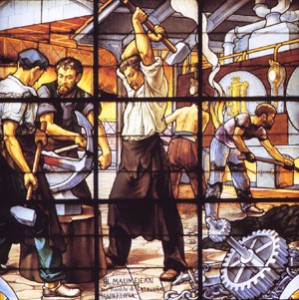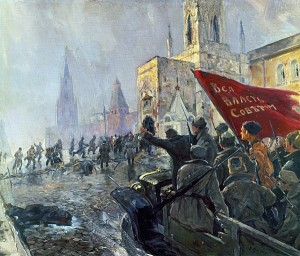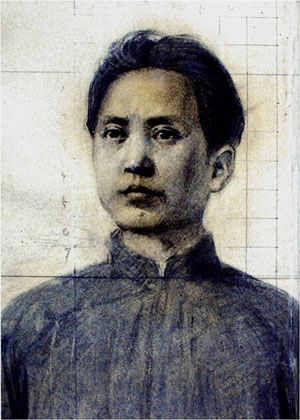1. LECTURE: Wednesday, August 24
Leadership versus Institutions. As you can see on the home page, I seek to answer four questions in this course:
1) Why was world communism appealing?
2) What caused it to become deformed?
3) Why did it last as long as it did?
4) Why did it fail?
To answer these questions, I will introduce two factors two factors that recurrently arise in the study of communism. These factors are the sometimes complementary, sometimes contradictory roles of leadership and institutions. I will also argue that we should study world communism as a process of development, and not as a fixed and immutable identity. This is an important point because it helps us to understand why not all communist regimes ended up looking the same.
2. DISCUSSION SECTION: Friday, August 26
For this discussion section, read both of the articles below. Cohen and “Z” (the historian Martin Malia) take fundamentally different approaches to the study of world communism. Cohen emphasizes human volition (leadership), Malia emphasizes structure (institutions). As we shall see throughout this course, the two approaches have significantly different implications for how we understand our subject matter. For now, you only need to concentrate on identifying and internalizing the authors’ basic arguments. Don’t worry about the details. We will address the events behind their positions as we move through the 20th century.
-
Stephen F. Cohen, Rethinking the Soviet Experience, ch. 2: Course Reader
-
“Z” (Martin Malia), “To the Stalin Mausoleum,” Daedalus, 119, 1 (1990): only sections I, II, XI, and XII. Course Reader
Writing assignment:
For this discussion section, please write a one-paragraph (no more!) response to the following question and turn it in to your TA.
“Why is Cohen’s critique of the Whig interpretation of history relevant to his debate with ‘Z’?”
Since you will examine the two articles closely, make sure you bring your Reader to this section.
3. LECTURE: Monday, August 29
The Founders: Karl Marx and Friedrich Engels’ Communist Manifesto. The Manifesto offers a convenient and concise outline of Marx’s prophecies about world revolution. It is also full of ambiguities, all of which are  important in the evolution of communism.
important in the evolution of communism.
-
Karl Marx and Friedrich Engels, The Communist Manifesto (1848). Read only sections 1, 2, and 4.
-
For a useful study guide on the Manifesto, see HERE
4. LECTURE: Wednesday, August 31
The (First) Rise and Fall of Communism: Western Europe. In this lecture, I will describe two different images of the path to socialism in Europe. As you read about them, imagine that you are living at the cusp of 20th century Europe: What key issues are Bernstein and Luxemberg raising? What conception would make the most sense to you?
-
Eduard Bernstein, Evolutionary Socialism (1899), Preface: HERE
-
Rosa Luxemburg, “Reform or Revolution” (1900). Read only the Introduction: HERE
5. DISCUSSION SECTION: Friday, September 2.
Writing assignment: “If, according to Marx, the bourgeoisie’s “fall and the victory of the proletariat are equally inevitable,” why do you need Communists to “point out and bring to the front the common interests of the movement as a whole”? Turn in this paragraph to your TA on Friday.
The goal of this section is to discuss not only what Marx says about world revolution but also how his remarks could be differently interpreted by successive generations of communists. Don’t forget to bring the Communist Manifesto to your discussion section.
6. LECTURE: Monday, September 5
The World Revolution’s unexpected Setting: Backward Russia. None of the early communists, not even Marx or Engels, expected their revolution to take place in Russia. In fact, Marx was adamant that it would not. Why did the revolution occur first in Russia?  One must consider the setting of the revolution in order to understand two essential facts about world communism: 1) why the Russian context was better suited than the modern industrial world to live up to Marx’s prophecies; and 2) how the fact that the revolution first occurred in this setting set the stage for conflict in the international communist movement for generations to come.
One must consider the setting of the revolution in order to understand two essential facts about world communism: 1) why the Russian context was better suited than the modern industrial world to live up to Marx’s prophecies; and 2) how the fact that the revolution first occurred in this setting set the stage for conflict in the international communist movement for generations to come.
-
R. Tucker, “Marxism and Modernization,” in your Course Reader.
-
William Rosenberg and Marilyn Young, Transforming Russia and China, pp. 3-34.
- St Petersburg: Palace Square
- St. Petersburg: Peterhof
7. LECTURE: Wednesday, September 7
Lenin asks and answers the Question: “What is to be Done?” Lenin provides the foundational definition of the Communist party. But 15 years later, he gives us some potentially contradictory suggestions about the utopian society to come. More than Marx, Lenin becomes the icon of world revolution.
-
Vladimir I. Lenin, What is to be Done? (1901-1902): Excerpts in the Course Reader. If you like, you can read the entire tract HERE.
-
Vladimir I. Lenin, State and Revolution (1917): Only the excerpts in the Course Reader. If you like, you can read the entire tract HERE.
-
Rosenberg and Young, Transforming Russia and China, pp. 35-71.
-
Background reading about Lenin: HERE.
- Sergei Eisenstein’s depiction of the Revolution: You Tube
8. DISCUSSION SECTION: Friday, September 9
What are the similarities between Lenin’s What is to be Done? and his State and Revolution? What are the differences? Are these differences necessarily contradictory? Is the first pragmatic, and the second merely propagandq?
One paragraph writing assignment: “In which of these two works do we find the real Lenin? Or do they both present us with the real Lenin?”
9. LECTURE: Monday, September 12
The Battles over the Russian Path to World Revolution. The idea of a proletarian world revolution seemed straightforward to the early Marxists. But when the revolution came to Russia instead of the West, the event unleashed a debate among Soviet leaders about the implications of this experience. Their conclusions about building socialism within their country were profoundly different.
-
Rosenberg and Young, Transforming Russia and China, 120-35, 147-66.
-
“Z,” “Stalin Mausoleum,” sections II-V. Course Reader
-
Nikolai Bukharin, “The New Economic Policy of Soviet Russia,” July 8, 1921: HERE (Print)
-
J. V. Stalin, “The October Revolution and the Tactics of the Russian Communists” (excerpt), Dec. 17, 1924: HERE (Print)
-
J. V. Stalin, “Bukharin’s Group and the Right Deviation in our Party,” January 1928: HERE (Print)
10. LECTURE: Wednesday, September 14
Making Revolution from Above versus Struggling from Below? In this lecture, I use the case of China to present two different paths to revolution. Then, I explain why these paths have had significant consequences for world communism.
-
Rosenberg and Young, Transforming Russia and China, pp. 72-119.
-
Sun Yatsen in Paris: HERE
-
Robert Tucker, “Marxism and Communist Revolutions”: HERE (Print)

-
Mao Zedong, “Report on an Investigation of the Peasant Movement in Hunan,” March 1927: HERE (Print)
11. DISCUSSION SECTION: Friday, September 16
One paragraph writing assignment: In many ways, Lenin’s What is to be Done? and Mao Zedong’s Report on the Peasant Movement in Hunan present different types of arguments. But, what primary feature do their arguments share in common? There is no single right answer to this question. Just pick the answer that you find most compelling.
The goal of this section is to provoke you into inquiring about the similarities and differences of communist movements in diverse settings. One cannot simply say that communism is the same wherever you go; this was the big mistake that American policymakers frequently made during the Cold War. Still, we don’t want to say that communist regimes were different wherever one found them. After all, if they were all different, why should we even use the same word “communist” to characterize them?
The use of electronic devices of any kind, including laptops, I-pads, cell phones, video cameras, and personal digital devices, is prohibited in my classroom!
Top of Page · Founders · Competitors · Defenders · Reformers · Losers